By Wolf Richter for WOLF STREET.
Demand for gasoline collapsed in a stunning and historic manner, starting in mid-March when the measures to slow down the spread of the pandemic took effect, when working from home became the new thing, and when millions of people lost their jobs on a weekly basis and stopped driving to work. Gasoline consumption, after bottoming out in the week ended April 3 with a year-over-year plunge of -48%, to 6.7 million barrels per day, the lowest in the EIA’s data going back to 1991, the great recovery began – and fizzled.
Gasoline consumption in the week ended June 12, at 7.87 million barrels per day, was still down 20.7% year-over-year, according to data reported by the EIA today. It has been about the same 20% year-over-year decline four weeks in a row:
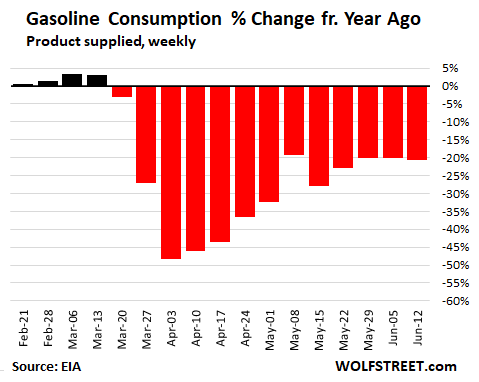
The EIA measures weekly consumption in terms of product supplied, such as by refineries and blenders, and not by retail sales at gas stations.
The level of gasoline consumption of 7.87 million barrels per day is still below any pre-pandemic consumption levels since the week in September 2001 after the 9/11 attacks. The WTF moment came in late March and April, when gasoline consumption collapsed. Even now, gasoline consumption remains below the low points during the Great Recession. And this is the beginning of driving season!
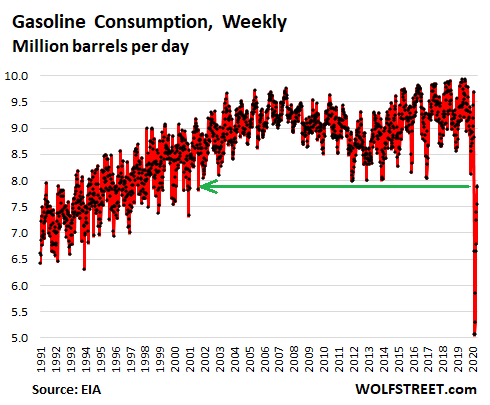
Gasoline hasn’t been exactly a booming business since around 2005. The decline in consumption during the Great Recession was followed by a recovery and finally new records starting in 2016. In other words, no growth for a decade.
Jet fuel.
Consumption of jet fuel (kerosene type) in the US – based on jet fuel supplied, the EIA’s proxy for consumption – began to get hit in February as flights from the US to China were being cancelled. In April and May, demand for jet fuel collapsed by as much as 80% year-over-year in the two worst weeks. And in the week ended June 12, according to data released today by the EIA, consumption of jet fuel, was still down 53% from a year ago:
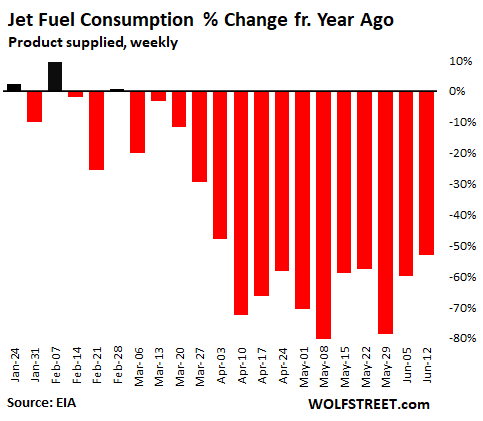
Demand for jet fuel had collapsed to just 352,000 b/d in the week ended May 8, by far the lowest in the data going back to 1991. In the week ended June 12, jet fuel consumption was 788,000 b/d, still far below any pre-pandemic consumption levels going back to 1991:
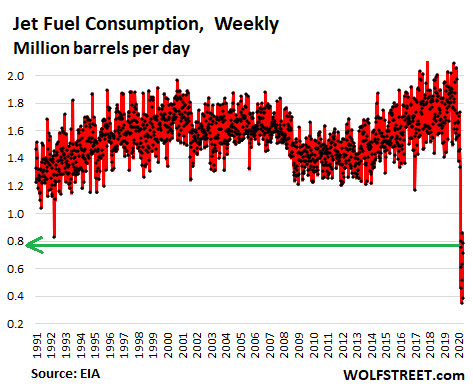
Distillate.
Distillate includes diesel fuels used by trucks and some cars, railroad engines, agricultural implements, diesel generators, and the like. It also includes fuel oils, such as for space heating and power generation, where demand is very seasonal, with spikes during heating season. So this is volatile and impacted by the weather. Nevertheless, trucking and railroads have been in a sharp decline for over a year, and this shows up in the consumption of distillate.
In the week ended June 12, distillate consumption was down 12.2% from last year. It has been down for most of this year so far, but the year-over-year declines steepened in April and May. The decline, maxing out at -25%, however is pale compared to -48% during the worst week for gasoline and -80% during the worst two weeks for jet fuel.
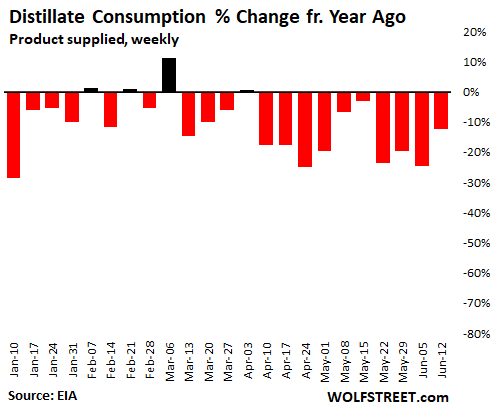
At 3.55 million b/d in the week ended June 12, distillate consumption remains were it had been over two decades ago:
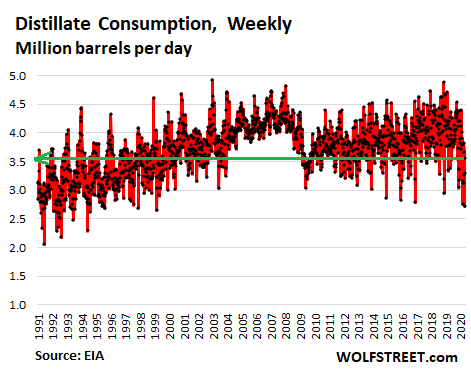
Combined total still down 22%.
Gasoline, jet fuel, and distillate consumption combined was still down by 22% year-over-year in the week ended June 12. At 12.21 million b/d, it was still below pre-pandemic consumption levels going back to April 1999 (12.23 million b/d) and December 1998 (12.24 million b/d), which were close.
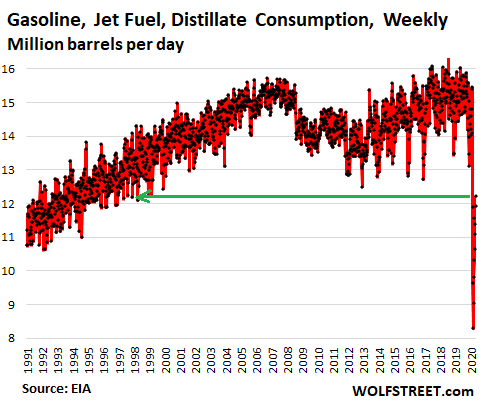
This is the scenario that the US oil industry is facing: An unprecedented plunge in consumption that even in mid-June remains 22% below last year – a plunge that, while not as bad as it was in April, seemed unthinkable just a few months ago.
Consumption will gradually increase from here. But looking at what happened during and after the Great Recession, it will likely take years for demand to recover, even after the 30 million or so people who’ve lost their jobs are working and commuting again.
And there is a good chance combined consumption will not recover fully to its prior peak levels for a number of reasons.
All automakers are switching part of their production to EVs. Over the next few years, EVs will play an ever-larger role in the national fleet and will eventually put a visible dent in gasoline consumption, and oil companies are concerned about that, because no one wants to be in a business that faces long-term structural decline.
At the same time, working-from-home at least part of the time will be the new model for many workers. And in terms of jet fuel, teleconferencing is taking the place of a good number of business trips, and the fact that this works just fine and saves a lot of time and money is now being proven on a daily basis.
This is one more way in which this crisis will leave its long-term imprint on the economy. And the old normal is gone for good.